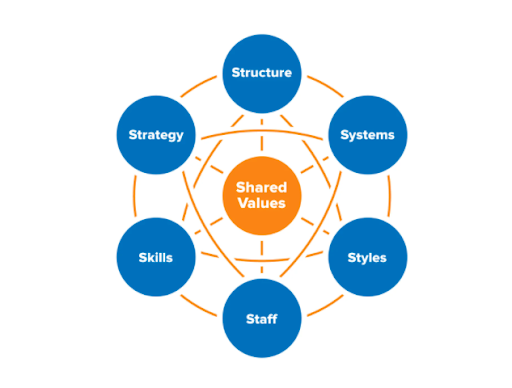
While traveling on a train, you must have heard an automated voice saying, “Please Mind the Gap.” It tells you to be careful when the doors are about to close. Similarly, even in the business world, “gaps” or improvement areas are not safe and must be identified and resolved with the help of gap analysis.
No matter what goals you set for your business – attaining million-dollar sales or increasing operational productivity, you need to create a gap analysis strategy. This will help you bridge the gap between current performance and true potential.
But in order to close gaps, you need to identify them first. After all, how can you close something that you cannot see?
In this blog, we will understand the purpose, benefits of gap analysis and explore steps that will help you identify and close the major gaps in your organization.
But before we jump to the main sections, let’s first start with the gap analysis definition.
What is Gap Analysis?
Gap analysis is a process organizations use to measure and analyze performance against set goals. This popular process can help you identify the difference between the “current” or actual state of your business and the “desired” or ideal state.
In simpler terms, the term “gap” here refers to the difference between “where your business is currently” and “where it wishes to be.” The bigger the gap, the more problems you have at your hand that must be resolved at the earliest.
A well carried out gap analysis process can help you find answers to questions such as:
- At what stage is our business now?
- Where do we wish we were?
- What can we do to close this growing gap?
What is the Purpose of Performing Gap Analysis?
The purpose of gap analysis is simple — it helps your business improve upon its current state. By conducting gap analysis, you can improve your product, enhance process efficiency, and increase profits by identifying the various “gaps” present in your company.
Once you are done with the process, leaders can understand exactly what needs to be improved. You can then allocate the necessary resources and energy to those identified areas and get closer to your desired goals.
Gap analysis has multiple applications and can be seen in almost every industry or vertical. For instance, in the field of project management, project managers use gap analysis along with lean methodology to meet client deadlines, enhance efficiency, and attain operational improvement. Similarly, the human resources department can conduct a gap analysis to determine which skills are present in employees and which additional skills must be learned.
When to Perform Gap Analysis
Gap analysis can be performed wherever and whenever you wish to improve your business and reach your full potential. All you need to do is think of areas where there can be a gap in actual performance and desired performance.
For example, if you notice that your sales targets are not being met for a long period, you can conduct a gap analysis to understand what could be the underlying causes for the same. Here are more such areas that you can improve:
- Sales
- Quality Control
- Supply Management
- Financial Performance
- Human Resources
- Employee Performance
- Employee Satisfaction
Benefits of Gap Analysis
The most important benefit of a gap analysis is that it makes you think in a very clear and structured way about your current state, your desired future state, the gaps between the two, and your plan of action.
It also provides a framework for people to collaborate in the first few steps of creating a strategic plan. Let’s look at some of the top benefits of gap analysis.
1. Get an Overview of Your Organization
One of the top advantages of gap analysis is that it can offer a comprehensive overview of your entire organization. This way, company leaders and executives can determine whether the organization or different departments have the necessary resources to meet their set goals.
2. Identify Gaps in the Market
Sometimes there can be a major difference between your product’s current and potential market size. With the process of Gap analysis, your organization can understand your current market size, full market potential, and how much you can expand further.
3. Conduct Profit Analysis
When your business is not able to attain an expected level of profit, you can conduct a gap analysis to understand why the profit targets were not met. You can identify causes of low profits, such as poor resource allocation, increased competition, changes in government policies, etc.
4. Understand Improvement Areas
You can dig a little deeper to understand the “why” of every outcome. With the help of gap assessment, you can uncover the major improvement areas of a department or the entire organization and bridge the growing gap between actual and expected results.
FREE. All Features. FOREVER!
Try our Forever FREE account with all premium features!
Steps to Conduct Gap Analysis
Wondering how to conduct a gap analysis? Well, don’t worry, as we have simplified the entire process for you. Let’s learn to conduct gap analysis in 4 easy steps.
1. Understand Your Current State
The first and foremost step is to pick an area of your organization that you wish to focus on. Once you have shortlisted an area, you need to understand its current state.
For example, let’s assume you wish to understand and improve customer satisfaction related to your product or service.
For this, you need to share CSAT (customer satisfaction) surveys with customers who are currently using your products or services. The results of the survey will help you see the bigger picture. To make things easier, you can calculate the average customer satisfaction score and then move to the next step.
2. Figure Out Your Ideal or Desired State
Once you have understood your current state and how you are currently performing, you need to foresee the future. Where do you see your business in the next month or year? How do you wish to be perceived by your customers? What is the best-case scenario for your business?
For example, let’s assume you received 3.2 as your average customer satisfaction rating. Now, you need to identify what is the ideal rating that you wish to achieve. This will be your ideal or desired state. For most businesses, it will be attaining an average rating of 4.5.
There are multiple ways to figure out your ideal state. You can refer to your leading competitors and see how they are performing. You can even look for industry benchmarks to raise the bar for your team.
3. Identify What Factors Are Causing the “Gap”
If your “current” state falls short of the “ideal” state then you need to put in the hard work and reduce the gap. In this step, you need to find out what factors are causing this gap between your performance and potential.
For example, you need to find out where your product/service misses hitting the mark. The potential reasons for customer dissatisfaction can be:
- Highly-priced product/service
- Lack of quality customer support
- Missing features as promised by your brand
- Faulty onboarding process
- Rude behavior of sales or support staff
4. Create a Robust Plan to Bridge the Gap
The purpose of gap analysis isn’t simply to identify issues; it also helps you look for their possible solutions. In the last step, you need to go back to the drawing board, create a plan, and find better ways to bridge the gap.
For example, if in your surveys, a lot of customers displayed their unhappiness with support quality or delayed responses, one solution could be to invest in help desk software. This will help you automate your process and track all your customer conversations in one place.
Similarly, if customers complain about missing or faulty features, you can ask your product team to revisit their design and make necessary changes. Such actionable steps will help your business reach its full potential and enhance the customer experience.
Gap Analysis Examples
The right gap analysis examples can act as a beacon and inspire you to enhance business performance. Here are a few examples that illustrate the scope of gap analysis in various areas:
1. Product Evaluation
Product evaluation refers to the process of monitoring a product’s overall success and safety for use by consumers. With gap assessment, you can understand whether the features and functionalities offered by the product work as promised by your business. You can take customer feedback and understand what areas need improvement for your product to become an instant hit in the market.
2. Sales Performance
Every business, big or small, is completely dependent on sales. After all, higher sales mean more profits and business longevity. The sales team can conduct a gap analysis to measure the gap between actual sales and the sales forecast or targets. Once they have identified the reasons, they can mold their marketing efforts to meet targets in the next quarter. In case the targets are met or exceeded, you can offer your sales professionals appropriate incentives.
Types of Gap Analysis
Here are some common types of gap analysis that you will find useful:
Profit Gap Analysis
When your business is not able to achieve desired profits, gap analysis can help you understand what went wrong. You can identify factors that led to low profits, such as shifting market trends, rising competition, or unforeseen political implications.
Product Gap Analysis
Product gap analysis can help you realize whether your product is able to meet customer expectations or not. What are the missing features that are offered by the competitors? How do we make our product more market-ready? How can we improve the design or packaging?
Skills Gap Analysis
The skills gap analysis focuses on the skills of the employees. How are your teams performing? What skills are missing to achieve the business goal? What education or training could fill the gaps?
IT Gap Analysis
This type of gap analysis involves an in-depth assessment of the efficiency and usability of the company’s IT resources. For example, is there a particular process that software could automate to achieve business goals?
Gap Analysis Tools
There are multiple tools for gap analysis that are used by organizations across the globe. Based on your unique needs, you can implement them and take your business to the next level.
1. SWOT Analysis

SWOT is one of the most popular gap analysis techniques that is taught not just to MBA students but high school kids too. It stands for Strengths, Weaknesses, Opportunities, and Threats. This process will help you see the bigger picture and identify internal, as well as, external factors that contribute to your company’s overall strengths and weaknesses.
The best part about this gap analysis tool is that it helps you resolve your company’s weaknesses without losing focus on the strengths. You can even save your business from current threats (such as rising competition) and grab opportunities such as (demand for a new product).
2. Nadler-Tushman Congruence Model

The Nadler-Tushman Model, also known as the Congruence Model, was developed in the early 1980s by two theorists, David Nadler and Michael Tushman. It is a powerful tool that helps you identify the root causes of performance problems.
This technique is based on the idea that a business can only achieve its true potential when there is a proper balance between the work, the people, the organizational structure, and the culture. When these areas are “congruent”, any organization can achieve success.
3. Fishbone Diagram
Fishbone Diagram is another impactful gap analysis tool that helps you identify the root causes of a particular problem. Let us understand how this diagram works.
A fishbone diagram offers an easy-to-understand, visual representation of cause and effect. The problem is displayed at the head or mouth of the fish, whereas the contributing causes are written on the smaller “bones” under multiple cause categories.
To make this process more interactive, you can include staff members who have worked on that process. They will be able to offer valuable insights and take this investigation ahead.
4. Mckinsey 7S

This popular framework was developed by former consultants of Mckinsey & Company and has stood the test of time. The McKinsey 7-S Model identifies seven internal elements of an organization that must be in sync for it to be successful. These elements are Shared Values, Structure, Systems, Styles, Staff, Skills, and Strategy.
The model emphasizes that all these elements are interconnected, and it’s challenging to make progress in one specific area without making relevant progress in other areas as well. You can use this framework to align different internal departments or examine the effects of future changes in the organization.
FREE. All Features. FOREVER!
Try our Forever FREE account with all premium features!
End the “Gap” with Gap Analysis
If you look closely, even billion-dollar businesses such as Apple or Microsoft are not perfect. They have multiple improvement areas or “gaps” that are closed with the help of gap analysis.
To conduct gap analysis in your organization, understand your current state, find your ideal state, identify the factors contributing to the “gap”, and use relevant tools to attain your true potential.
Remember that analyzing gaps in business is an ongoing process. Tracking its impact will help you identify what’s working well and what isn’t so that you can make lasting progress for your organization and your employees. A tool such as ProProfs Survey Maker can help you with gap assessment in areas such as customer satisfaction, product launch, employee engagement, market research, and more.
 Tips
Tips
We’d love to hear your tips & suggestions on this article!
FREE. All Features. FOREVER!
Try our Forever FREE account with all premium features!


 We'd love your feedback!
We'd love your feedback! Thanks for your feedback!
Thanks for your feedback!







